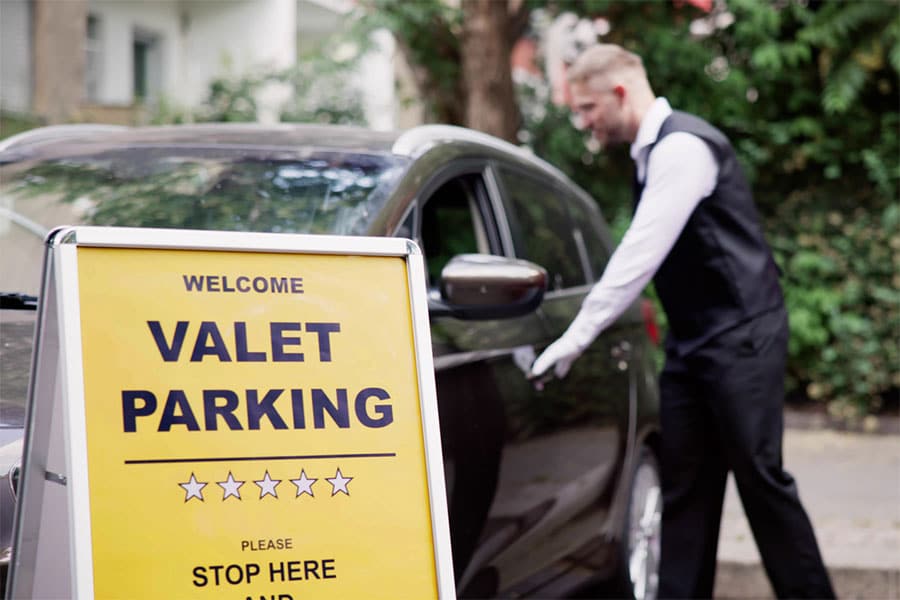You know and love us for our exceptional DTW valet parking, but we also want to educate you, our valued customers. Check out some lesser known questions and answers we have put together for you here at Valet Connections.
Why is it Called Valet Parking?
The term “valet” was originally coined in reference to a male servant who waited on his employer hand and foot with clothing, personal needs, and even caring for his horse. As the early 20th century rolled around, restaurants and hotels in urban areas started offering parking services to their customers, using the term “valet parking”.
The attendant would then treat the customer’s car as if it were his own, putting lots of care and attention into the job just like a personal valet would do for his employer’s personal belongings such as clothing. Over the years, though, the term became more closely associated with the actual act of parking a customer’s car, whether the attendant provided other personal care services or not.
When Did the First Valet Parking Concept Begin?
In the 1920s, street railway companies created some of the first private parking lots in an attempt to gain customers by providing plenty of parking spaces at their suburban terminals. “Park with Us and Ride with Us”, the slogan of the Philadelphia Rapid Transit Company, was designed to attract potential customers to three large parking areas that could accommodate 870 cars throughout the city.
They charged 25 cents per car in 1927, with no time limits set except an additional fee for cars parked for more than 24 hours. There were attendants on duty day and night, and that was the status quo at most parking lots back then: guards and supervision.
Attendants would handle the actual parking, whereby a large staging area was positioned near the entrance. This is where customers would leave their cars. Customer self-parking became the standard for the middle class with the increasing popularization of the automobile after the Second World War, eventually replacing attended parking.
Where Was the First Airport?
While the concept of airports (areas for the landing and takeoff of aircraft) has been around for as long as we have been flying, the airports as we know them now did not exist till the 20th century. Thanks to aviation technology advancements, planes started to fly longer distances while carrying more passengers. The first recorded airport was in Maryland in 1909, at College Park Airport, established by the U.S. Army Signal Corps. It was created as a training ground for military pilots, then became a civilian airport in 1926 when it served the first commercial flight in this country.
What’s the History of the Detroit Metro Airport?
Let’s take a look at the history of our beloved Detroit Metro Airport.
1929: In April, ground-breaking for Wayne County Airport begins.
1930: On September 4, the Wayne County Airport opens in Romulus, MI at Wick and Middlebelt roads.
1940: The U.S. Army takes control of the Wayne County Airport as a staging base for transport military aircraft to Europe. With the addition of new hangars and runways, the airport has been renamed Romulus Army Air Field.
1944: The U.S. Army releases the airport.
1947: Wayne County Airport is now called Detroit-Wayne Major Airport and measures four square miles.
1956: A new device allows Civil Aeronautics Administration (CAA) controllers to scan for aircraft 200 miles away.
1958: Detroit-Wayne Major Airport morphs into Detroit Metropolitan Wayne County Airport (DTW); Terminal 1 opens.
1966: Terminal 2 opens. There are 13 passenger airlines at DTW.
1967: Terminal 1 has been renamed the L.C. Smith Terminal.
1974: The Michael Berry International Terminal is now built.
1975: Terminal 2 is renamed J.M. Davey Terminal.
1978: Deregulation takes control away from the government and airlines can now set their own routes and fares.
1986: Northwest Airlines creates a hub at Detroit Metropolitan Airport.
1992: The FAA unveils the $15 million Air Traffic Control Tower, the tallest in the Great Lakes Region.
1996: A new Midfield Terminal is planned.
1997: Crosswinds Marsh nature preserve replaces disturbed wetlands at Detroit Metropolitan Airport from new runway construction.
2001: Runway 4L/22R opens, creating a runway configuration of two crosswind runways and four parallel runways.
2002: Detroit Metropolitan Airport’s Midfield Terminal opens.
2005: The J.M. Davey Terminal is demolished so the new North Terminal can be built.
2008: The North Terminal is opened at Detroit Metropolitan Airport.
2009: Delta Air Lines is the hub airline at DTW.
2010: Detroit Metropolitan Airport is ranked highest in overall customer satisfaction according to a J.D. Power and Associates 2010 North America Airport Satisfaction Study.
2011: The Airport Authority Fire Department is the first in the country to get international accreditation from the Center for Public Safety Excellence, Commission on Fire Accreditation International (CFAI).
2012: The Ground Run-up Enclosure (GRE) opens to cut back on noise in nearby communities.
2019: DTW is chosen by Airports Council International (ACI) as one of the best airports by category and size in North America for customer service – an extremely high honor in the aviation industry.
2023: DTW is awarded the 2022 Airport Service Quality (ASQ) Award for “Best Airport of 25 t- 40 million passengers in North America.”
2023: Sun Country Airlines, WestJet and Icelandair are included in air carrier service, bringing the total number of passenger airlines to 16.
2023: DTW is #1 in customer satisfaction for mega airports by J.D. Powers 2023 North America Airport Satisfaction Study.
2023: In November, DTW welcomed Turkish Airlines, increasing to 17 the number of passenger carriers.
Contact Valet Connections DTW Parking
We hope you learned a little bit of new information with Valet Connections today. Contact us at (734) 992-4946 to reserve your valet service now for your upcoming airport trip.


